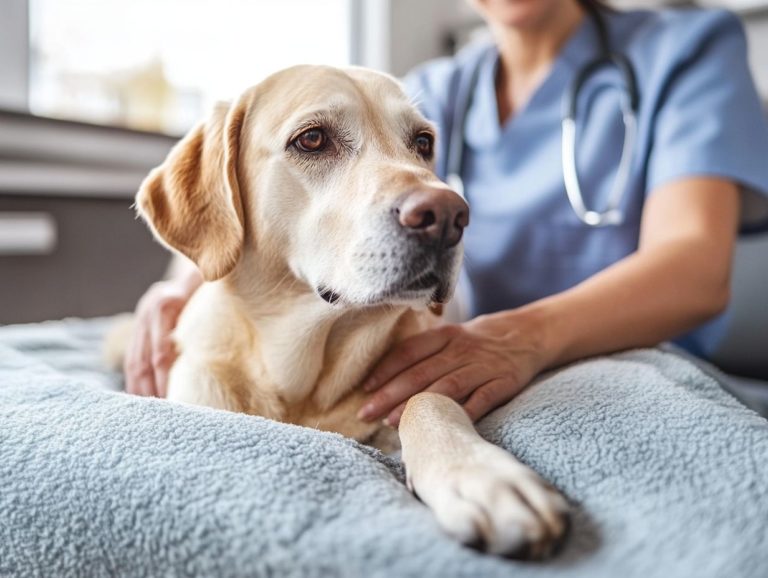How to Help Your Anxious Pet Feel Safe
Pets can experience anxiety just like humans. This can lead to behavior changes that may raise concerns for you as a pet owner.
Understanding the causes and triggers of pet anxiety is essential for recognizing the signs that your furry companion might be struggling.
Let s explore together how to create a cozy haven for your pet! This article offers calming techniques and tips for nurturing your pet’s emotional well-being.
Whether you’re facing occasional stressors or more serious anxiety issues, the insights provided here will empower you to help your pet feel secure and happy.
Contents
- Key Takeaways:
- Understanding Pet Anxiety
- Signs of Anxiety in Pets
- Creating a Safe Environment for Your Pet
- Reducing Stressors and Providing Comfort
- Calming Techniques for Anxious Pets
- Natural Remedies and Behavioral Training
- Seeking Professional Help
- When to Consult a Veterinarian or Animal Behaviorist
- Supporting Your Pet’s Emotional Well-being
- Frequently Asked Questions
- How to help my anxious pet feel safe at home?
- What are some signs that my pet may be feeling anxious? How can I recognize early signs of anxiety in my furry friend?
- How can I make my pet feel safe during a thunderstorm? Can I use ThunderCloud for added comfort?
- Is exercise beneficial for anxious pets? Yes, it’s crucial to exercise your dog to help them manage their anxiety.
- Can I use natural remedies to help my pet feel calm and safe? Definitely, consider products like Petstages and play calming games as part of your approach.
- What should I do if my pet’s anxiety is severe? Seek out a James Law Professor Emeritus or an expert like Patricia McConnell for guidance.
Key Takeaways:

- Recognize signs of anxiety in your pet, such as behavioral changes, to better understand their needs and triggers.
- Create a safe and stress-free environment for your pet by reducing potential stressors and providing comfort and support.
- Utilize natural remedies and behavioral training; seek expert sessions if needed to help your anxious pet feel calmer and more at ease.
Understanding Pet Anxiety
Understanding pet anxiety is essential for every dog owner, especially in 2023. Resources like the AKC GoodDog Helpline are at your fingertips to help tackle these issues.
Many dogs experience anxiety due to various factors, from environmental triggers to behavioral problems. This can profoundly affect their quality of life.
By recognizing the signs and grasping the underlying causes, you can take proactive steps to support your furry companion. Whether you’re navigating the challenges of an anxious dog during thunderstorms or managing general stress, learning how to identify if your pet has anxiety can significantly enhance your pet’s happiness and well-being.
Causes and Triggers
The causes and triggers of anxiety in dogs can vary significantly. Factors such as environmental changes, past trauma, or a lack of socialization can result in a fearful dog and unwanted behaviors.
Consider loud noises like thunder or fireworks. They can create deep-seated fear in your canine companion. Unfamiliar situations, like moving to a new home or encountering strange people, can further heighten their anxiety.
Understanding these triggers is crucial for pet owners. Professional sessions with experts who can help you understand your dog’s needs offer tailored strategies to identify and mitigate the stimuli causing your dog’s distress.
Addressing common questions during these consultations can provide valuable insights. This paves the way for both you and your dog to enjoy a more harmonious living environment.
Signs of Anxiety in Pets
It’s vital to recognize anxiety signs in pets. An anxious dog may display a range of symptoms, from subtle shifts in behavior to more pronounced expressions of distress, including fearful dog reactions.
Being attuned to these signs allows you to provide the appropriate care and support your furry companion requires.
Recognizing Behavioral Changes
Recognizing behavioral changes in your pet is crucial. These often serve as early indicators of underlying anxiety, signaling the need for immediate attention and potential behavior modification.
For example, if you notice alterations in your pet’s sleeping patterns like excessive lethargy or restless pacing during the night it may indicate unease.
A sudden withdrawal from social interactions or activities they once relished can reflect their inner turmoil.
Understanding dog anxiety is essential for you as a pet owner. It fosters empathy and equips you with the tools to implement effective solutions. Consistent exercise can significantly alleviate these issues.
Physical activity helps release pent-up energy and reduces stress, ultimately leading to a happier and more balanced furry companion.
Creating a Safe Environment for Your Pet

Establishing a secure environment for your pet is essential in alleviating their anxiety and fostering a sense of comfort, especially when considering how to help a rescue pet with anxiety.
This thoughtful approach enhances their well-being and contributes to a joyful life for both you and your beloved companion.
Help your pet thrive by creating a safe space! Start today!
Reducing Stressors and Providing Comfort
Reducing stressors and providing comfort for your dog can greatly alleviate their anxiety. Learning how to recognize and address anxiety in pets involves various activities and environmental adjustments that can foster a sense of security.
To create a tranquil atmosphere, minimize loud noises, especially from fireworks or thunderstorms. These sounds can be particularly distressing for your furry friend. Engage your dog in calming activities, such as puzzle toys or gentle fetch. This not only keeps them mentally stimulated but also helps channel their energy positively.
Incorporating calming supplements supports anxiety management effectively. By combining these strategies, you can cultivate a more peaceful environment that significantly enhances your pet’s overall well-being and happiness.
Calming Techniques for Anxious Pets
Calming techniques can include a blend of natural remedies and behavioral training strategies. These provide effective solutions to help your dogs manage anxiety.
By integrating these approaches, you can create a soothing environment that fosters your pet’s well-being and resilience.
Natural Remedies and Behavioral Training
Natural remedies and behavioral training work together beautifully, offering a holistic approach to calm your anxious dog. This makes it easier for them to adapt and flourish.
Consider using calming coats that gently apply pressure to your pup’s body; they can significantly reduce stress levels. You might also explore specific treats made with chamomile or lavender, which serve as soothing snacks during particularly anxious moments.
While these remedies can offer temporary relief, establishing a consistent training routine early on is essential. Teaching basic commands and gradually introducing your puppy to various environments sets the stage for long-term emotional well-being.
This thoughtful blend of natural solutions and proactive training nurtures resilience. It ensures your canine companion feels secure and confident in any situation.
Seeking Professional Help
Seeking professional help is crucial for managing your dog’s anxiety. This is especially true if you notice persistent symptoms that remain unchanged despite simple interventions.
Engaging with a specialist provides tailored support and strategies to improve your dog’s well-being effectively.
When to Consult a Veterinarian or Animal Behaviorist

Knowing when to consult a veterinarian or animal behaviorist can transform your approach to addressing severe anxiety symptoms. It also helps in implementing effective dog training strategies.
Recognizing early warning signs like excessive barking, destructive behavior, or sudden withdrawal dictates whether the situation is manageable at home or requires professional intervention. When basic training techniques fail or when underlying health concerns arise, seeking expert advice becomes essential.
Professionals bring a wealth of expertise and the right tools to create a customized plan. This plan not only alleviates anxiety but also nurtures a healthier, balanced relationship between you and your dog. This collaboration often leads to sustainable outcomes, ensuring your pet’s well-being remains the top priority.
Supporting Your Pet’s Emotional Well-being
Supporting your pet’s emotional well-being is essential for nurturing a calm and composed dog. By cultivating a strong bond and encouraging positive behaviors, you ll see a remarkable improvement in their overall quality of life.
Try these techniques today and consult a professional if you notice persistent issues. Your furry friend deserves the best!
Building a Strong Bond and Promoting Positive Behaviors
Building a strong bond with your dog through training techniques and positive reinforcement is crucial for creating an emotionally balanced and confident pet.
Integrating exercise into your training routine is just as important. Regular exercise is a fun way for your dog to release energy and feel more at ease. It channels your dog s energy in a constructive way, helping to reduce anxiety and promote good behavior.
Teaching your dog to settle in a designated spot or during quiet moments significantly enhances your living environment. Not only does this support their emotional stability, but it also makes addressing behavioral challenges much easier.
Together, these elements create a solid training strategy that nurtures a trusting relationship. Ultimately, this leads to a well-mannered and happy companion, ensuring a promoting a happy life for both you and your dog.
Frequently Asked Questions
How to help my anxious pet feel safe at home?
There are several things you can do to help your anxious pet feel safe at home. One of the most important is to create a safe and secure environment. For guidance, check out how to help an anxious pet adjust to new environments. This can include providing a designated area for your pet to retreat to, using soothing scents or soft music, and making sure there are no loud or sudden noises that could startle your pet.
What are some signs that my pet may be feeling anxious? How can I recognize early signs of anxiety in my furry friend?

Signs of anxiety in pets can vary. Some common signs include pacing, excessive barking or meowing, destructive behavior, changes in appetite, and hiding.
If you notice any of these signs in your pet, it may be a good idea to consult with a veterinarian to determine the best course of action.
How can I make my pet feel safe during a thunderstorm? Can I use ThunderCloud for added comfort?
Thunderstorms can be a source of anxiety for many pets. To help your pet feel safe during a storm, ensure they have a quiet place to retreat to, close the curtains to block out flashes of lightning, and consider supporting your anxious pet with a comforting item, such as a favorite toy or blanket.
Is exercise beneficial for anxious pets? Yes, it’s crucial to exercise your dog to help them manage their anxiety.
Exercise can be a great way to help your pet release pent-up energy and reduce anxiety. However, it’s important to provide appropriate exercise for your pet’s breed and age. Consult with your veterinarian for recommendations on the best exercise routine for your furry friend.
Can I use natural remedies to help my pet feel calm and safe? Definitely, consider products like Petstages and play calming games as part of your approach.
Yes, there are several natural remedies that can help relieve anxiety in pets. These include herbal supplements, essential oils, and calming pheromone sprays. However, if you notice a significant change, it’s important to know what to do if your pet’s anxiety worsens.
It’s important to consult with your veterinarian before trying any natural remedies to ensure they are safe for your pet.
What should I do if my pet’s anxiety is severe? Seek out a James Law Professor Emeritus or an expert like Patricia McConnell for guidance.
If your pet’s anxiety is severe and impacting their daily life, it’s crucial to seek guidance from a veterinarian or animal behaviorist. They can help determine the root cause of your pet’s anxiety and develop a treatment plan that may include understanding the needs of anxious pets, behavior modification techniques, medication, or a combination of both.






